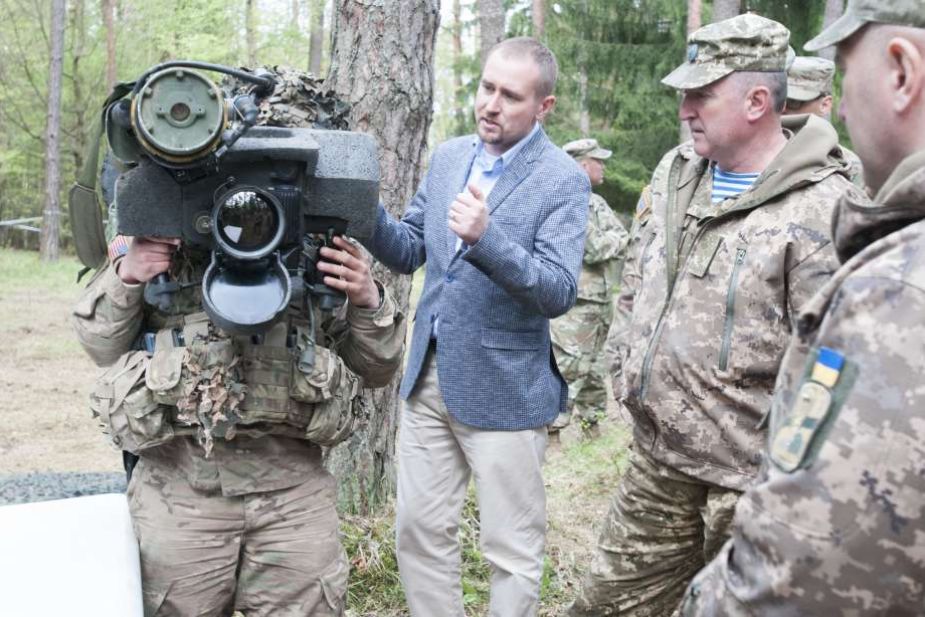Breaking News
US Army Secures $1.3 Billion Contract for Javelin Missiles Including 4,000 for Ukraine.
The U.S. Army has awarded the Javelin Joint Venture (JJV) a follow-on production contract for fiscal year 2024. The contract covers the production of Javelin missiles and related equipment and services, with a total value of $1.3 billion. The contract also includes more than 4,000 Javelins to replenish missiles sent to Ukraine.
Follow Army Recognition on Google News at this link

A U.S. soldier demonstrates to Ukrainian soldiers how to use the Javelin anti-tank missile system.(Picture source: U.S. DoD)
This contract, covering the fiscal year 2024, underscores the U.S. commitment to maintaining its advanced weaponry inventory while supporting Ukraine amid ongoing regional conflicts. The contract encompasses the production of Javelin missiles and associated equipment and services crucial for their deployment and operational effectiveness. One key component of the agreement is the inclusion of over 4,000 Javelin missiles specifically earmarked to replenish stockpiles that have been sent to Ukraine over the past year.
This contract facilitates the procurement of Javelin weapon systems and provides production support for the U.S. Army. Last year, the Javelin Joint Venture (JJV) initiated efforts to scale up production, aiming to increase the annual output of Javelin All Up Rounds (AUR) to 3,960 units by late 2026.
The Javelin missile system stands out for its exceptional armor-destruction capabilities, making it a top-tier anti-tank weapon in modern arsenals. Its tandem-charge warhead, with a precursor charge to neutralize reactive armor and a main charge to penetrate base armor, allows it to defeat even the most advanced armor systems on modern main battle tanks, including those with Explosive Reactive Armor (ERA).
One of the Javelin's most significant features is its top-attack flight profile, which allows the missile to strike the target from above, where the armor is typically thinner and less reinforced. Upon impact, the warhead can penetrate up to 800 millimeters of rolled homogeneous armor (RHA), effectively neutralizing heavily armored vehicles. The combination of these features—tandem-charge warhead, top-attack capability, and high penetration power—makes the Javelin exceptionally lethal against a wide range of armored threats on the battlefield.
The Javelin missile system boasts a maximum effective range of up to 4.75 km (approximately 2.95 miles), although it is typically used within a range of 2.5 km (about 1.6 miles) for optimal accuracy and effectiveness. This extended range capability empowers infantry units to engage armored targets from a safe distance, well beyond the reach of most enemy weapons, providing a significant tactical advantage in various combat scenarios.
As of the most recent reports, the United States has delivered over 10,000 Javelin missiles and several hundred launchers to Ukraine since the beginning of the conflict in February 2022. These deliveries have been part of a broader military aid package aimed at bolstering Ukraine's defenses against Russian aggression. The exact number of launchers is less frequently reported, but it is known that the U.S. has provided a sufficient quantity to support the extensive use of the Javelin missiles by Ukrainian forces on the front lines. The Javelin systems have played a crucial role in Ukraine's ability to counter Russian armored vehicles, contributing significantly to their defensive operations.
The Javelin missile system has proven to be highly effective in combat during the conflict in Ukraine, particularly in countering Russian armored vehicles. Ukrainian forces have used the Javelin extensively against Russian tanks and other armored units, with notable success. The missile's top-attack capability, which strikes tanks where their armor is weakest, has been particularly effective against Russian main battle tanks, including the T-72, T-80, and T-90 models.
Reports from the battlefield indicate that the Javelin has contributed to the destruction of hundreds of Russian tanks, often in situations where Ukrainian forces were outnumbered. Its fire-and-forget technology allows Ukrainian soldiers to engage targets from a distance and then quickly relocate, minimizing their exposure to counterattacks.


























